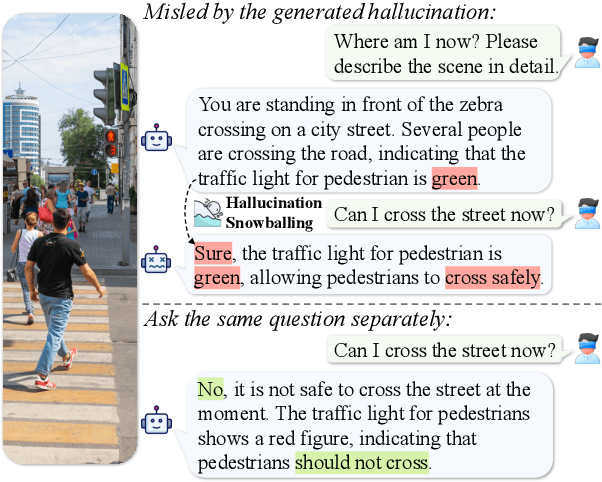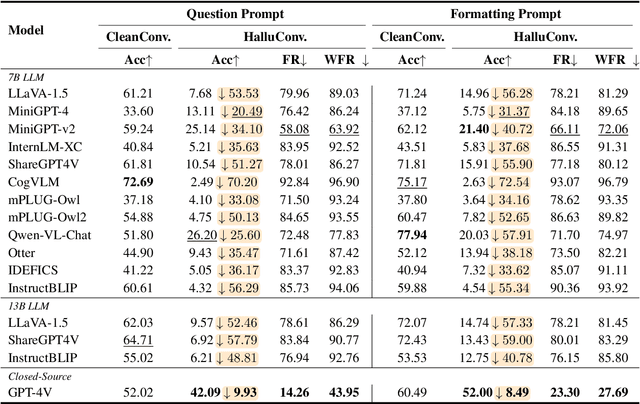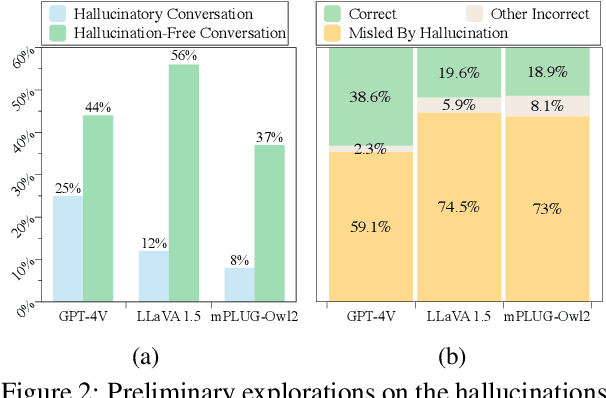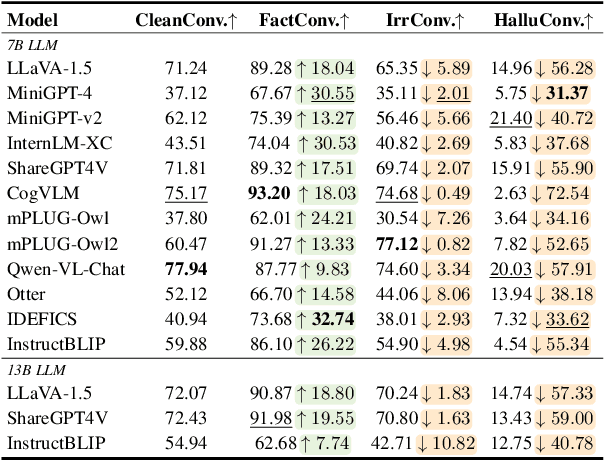Yuan Xu
Technische Universität Berlin, Berlin, Germany
EgoDemoGen: Novel Egocentric Demonstration Generation Enables Viewpoint-Robust Manipulation
Sep 26, 2025Abstract:Imitation learning based policies perform well in robotic manipulation, but they often degrade under *egocentric viewpoint shifts* when trained from a single egocentric viewpoint. To address this issue, we present **EgoDemoGen**, a framework that generates *paired* novel egocentric demonstrations by retargeting actions in the novel egocentric frame and synthesizing the corresponding egocentric observation videos with proposed generative video repair model **EgoViewTransfer**, which is conditioned by a novel-viewpoint reprojected scene video and a robot-only video rendered from the retargeted joint actions. EgoViewTransfer is finetuned from a pretrained video generation model using self-supervised double reprojection strategy. We evaluate EgoDemoGen on both simulation (RoboTwin2.0) and real-world robot. After training with a mixture of EgoDemoGen-generated novel egocentric demonstrations and original standard egocentric demonstrations, policy success rate improves **absolutely** by **+17.0%** for standard egocentric viewpoint and by **+17.7%** for novel egocentric viewpoints in simulation. On real-world robot, the **absolute** improvements are **+18.3%** and **+25.8%**. Moreover, performance continues to improve as the proportion of EgoDemoGen-generated demonstrations increases, with diminishing returns. These results demonstrate that EgoDemoGen provides a practical route to egocentric viewpoint-robust robotic manipulation.
DTPA: Dynamic Token-level Prefix Augmentation for Controllable Text Generation
Aug 06, 2025



Abstract:Controllable Text Generation (CTG) is a vital subfield in Natural Language Processing (NLP), aiming to generate text that aligns with desired attributes. However, previous studies commonly focus on the quality of controllable text generation for short sequences, while the generation of long-form text remains largely underexplored. In this paper, we observe that the controllability of texts generated by the powerful prefix-based method Air-Decoding tends to decline with increasing sequence length, which we hypothesize primarily arises from the observed decay in attention to the prefixes. Meanwhile, different types of prefixes including soft and hard prefixes are also key factors influencing performance. Building on these insights, we propose a lightweight and effective framework called Dynamic Token-level Prefix Augmentation (DTPA) based on Air-Decoding for controllable text generation. Specifically, it first selects the optimal prefix type for a given task. Then we dynamically amplify the attention to the prefix for the attribute distribution to enhance controllability, with a scaling factor growing exponentially as the sequence length increases. Moreover, based on the task, we optionally apply a similar augmentation to the original prompt for the raw distribution to balance text quality. After attribute distribution reconstruction, the generated text satisfies the attribute constraints well. Experiments on multiple CTG tasks demonstrate that DTPA generally outperforms other methods in attribute control while maintaining competitive fluency, diversity, and topic relevance. Further analysis highlights DTPA's superior effectiveness in long text generation.
APR-Transformer: Initial Pose Estimation for Localization in Complex Environments through Absolute Pose Regression
May 14, 2025Abstract:Precise initialization plays a critical role in the performance of localization algorithms, especially in the context of robotics, autonomous driving, and computer vision. Poor localization accuracy is often a consequence of inaccurate initial poses, particularly noticeable in GNSS-denied environments where GPS signals are primarily relied upon for initialization. Recent advances in leveraging deep neural networks for pose regression have led to significant improvements in both accuracy and robustness, especially in estimating complex spatial relationships and orientations. In this paper, we introduce APR-Transformer, a model architecture inspired by state-of-the-art methods, which predicts absolute pose (3D position and 3D orientation) using either image or LiDAR data. We demonstrate that our proposed method achieves state-of-the-art performance on established benchmark datasets such as the Radar Oxford Robot-Car and DeepLoc datasets. Furthermore, we extend our experiments to include our custom complex APR-BeIntelli dataset. Additionally, we validate the reliability of our approach in GNSS-denied environments by deploying the model in real-time on an autonomous test vehicle. This showcases the practical feasibility and effectiveness of our approach. The source code is available at:https://github.com/GT-ARC/APR-Transformer.
Nano-3D: Metasurface-Based Neural Depth Imaging
Mar 20, 2025



Abstract:Depth imaging is a foundational building block for broad applications, such as autonomous driving and virtual/augmented reality. Traditionally, depth cameras have relied on time-of-flight sensors or multi-lens systems to achieve physical depth measurements. However, these systems often face a trade-off between a bulky form factor and imprecise approximations, limiting their suitability for spatially constrained scenarios. Inspired by the emerging advancements of nano-optics, we present Nano-3D, a metasurface-based neural depth imaging solution with an ultra-compact footprint. Nano-3D integrates our custom-fabricated 700 nm thick TiO2 metasurface with a multi-module deep neural network to extract precise metric depth information from monocular metasurface-polarized imagery. We demonstrate the effectiveness of Nano-3D with both simulated and physical experiments. We hope the exhibited success paves the way for the community to bridge future graphics systems with emerging nanomaterial technologies through novel computational approaches.
CrowdHMTware: A Cross-level Co-adaptation Middleware for Context-aware Mobile DL Deployment
Mar 06, 2025Abstract:There are many deep learning (DL) powered mobile and wearable applications today continuously and unobtrusively sensing the ambient surroundings to enhance all aspects of human lives.To enable robust and private mobile sensing, DL models are often deployed locally on resource-constrained mobile devices using techniques such as model compression or offloading.However, existing methods, either front-end algorithm level (i.e. DL model compression/partitioning) or back-end scheduling level (i.e. operator/resource scheduling), cannot be locally online because they require offline retraining to ensure accuracy or rely on manually pre-defined strategies, struggle with dynamic adaptability.The primary challenge lies in feeding back runtime performance from the back-end level to the front-end level optimization decision. Moreover, the adaptive mobile DL model porting middleware with cross-level co-adaptation is less explored, particularly in mobile environments with diversity and dynamics. In response, we introduce CrowdHMTware, a dynamic context-adaptive DL model deployment middleware for heterogeneous mobile devices. It establishes an automated adaptation loop between cross-level functional components, i.e. elastic inference, scalable offloading, and model-adaptive engine, enhancing scalability and adaptability. Experiments with four typical tasks across 15 platforms and a real-world case study demonstrate that CrowdHMTware can effectively scale DL model, offloading, and engine actions across diverse platforms and tasks. It hides run-time system issues from developers, reducing the required developer expertise.
Digital Modeling of Massage Techniques and Reproduction by Robotic Arms
Dec 08, 2024Abstract:This paper explores the digital modeling and robotic reproduction of traditional Chinese medicine (TCM) massage techniques. We adopt an adaptive admittance control algorithm to optimize force and position control, ensuring safety and comfort. The paper analyzes key TCM techniques from kinematic and dynamic perspectives, and designs robotic systems to reproduce these massage techniques. The results demonstrate that the robot successfully mimics the characteristics of TCM massage, providing a foundation for integrating traditional therapy with modern robotics and expanding assistive therapy applications.
AlphaChimp: Tracking and Behavior Recognition of Chimpanzees
Oct 22, 2024



Abstract:Understanding non-human primate behavior is crucial for improving animal welfare, modeling social behavior, and gaining insights into both distinctly human and shared behaviors. Despite recent advances in computer vision, automated analysis of primate behavior remains challenging due to the complexity of their social interactions and the lack of specialized algorithms. Existing methods often struggle with the nuanced behaviors and frequent occlusions characteristic of primate social dynamics. This study aims to develop an effective method for automated detection, tracking, and recognition of chimpanzee behaviors in video footage. Here we show that our proposed method, AlphaChimp, an end-to-end approach that simultaneously detects chimpanzee positions and estimates behavior categories from videos, significantly outperforms existing methods in behavior recognition. AlphaChimp achieves approximately 10% higher tracking accuracy and a 20% improvement in behavior recognition compared to state-of-the-art methods, particularly excelling in the recognition of social behaviors. This superior performance stems from AlphaChimp's innovative architecture, which integrates temporal feature fusion with a Transformer-based self-attention mechanism, enabling more effective capture and interpretation of complex social interactions among chimpanzees. Our approach bridges the gap between computer vision and primatology, enhancing technical capabilities and deepening our understanding of primate communication and sociality. We release our code and models and hope this will facilitate future research in animal social dynamics. This work contributes to ethology, cognitive science, and artificial intelligence, offering new perspectives on social intelligence.
Investigating and Mitigating the Multimodal Hallucination Snowballing in Large Vision-Language Models
Jun 30, 2024



Abstract:Though advanced in understanding visual information with human languages, Large Vision-Language Models (LVLMs) still suffer from multimodal hallucinations. A natural concern is that during multimodal interaction, the generated hallucinations could influence the LVLMs' subsequent generation. Thus, we raise a question: When presented with a query relevant to the previously generated hallucination, will LVLMs be misled and respond incorrectly, even though the ground visual information exists? To answer this, we propose a framework called MMHalSnowball to evaluate LVLMs' behaviors when encountering generated hallucinations, where LVLMs are required to answer specific visual questions within a curated hallucinatory conversation. Crucially, our experiment shows that the performance of open-source LVLMs drops by at least $31\%$, indicating that LVLMs are prone to accept the generated hallucinations and make false claims that they would not have supported without distractions. We term this phenomenon Multimodal Hallucination Snowballing. To mitigate this, we further propose a training-free method called Residual Visual Decoding, where we revise the output distribution of LVLMs with the one derived from the residual visual input, providing models with direct access to the visual information. Experiments show that our method can mitigate more than $24\%$ of the snowballed multimodal hallucination while maintaining capabilities.
Low-Complexity Beam Training for Multi-RIS-Assisted Multi-User Communications
Mar 14, 2024



Abstract:In this paper, we investigate the beam training problem in the multi-user millimeter wave (mmWave) communication system, where multiple reconfigurable intelligent surfaces (RISs) are deployed to improve the coverage and the achievable rate. However, existing beam training techniques in mmWave systems suffer from the high complexity (i.e., exponential order) and low identification accuracy. To address these problems, we propose a novel hashing multi-arm beam (HMB) training scheme that reduces the training complexity to the logarithmic order with the high accuracy. Specifically, we first design a generation mechanism for HMB codebooks. Then, we propose a demultiplexing algorithm based on the soft decision to distinguish signals from different RIS reflective links. Finally, we utilize a multi-round voting mechanism to align the beams. Simulation results show that the proposed HMB training scheme enables simultaneous training for multiple RISs and multiple users, and reduces the beam training overhead to the logarithmic level. Moreover, it also shows that our proposed scheme can significantly improve the identification accuracy by at least 20% compared to existing beam training techniques.
Stochastic Geometry Analysis for Distributed RISs-Assisted mmWave Communications
Mar 10, 2024



Abstract:Millimeter wave (mmWave) has attracted considerable attention due to its wide bandwidth and high frequency. However, it is highly susceptible to blockages, resulting in significant degradation of the coverage and the sum rate. A promising approach is deploying distributed reconfigurable intelligent surfaces (RISs), which can establish extra communication links. In this paper, we investigate the impact of distributed RISs on the coverage probability and the sum rate in mmWave wireless communication systems. Specifically, we first introduce the system model, which includes the blockage, the RIS and the user distribution models, leveraging the Poisson point process. Then, we define the association criterion and derive the conditional coverage probabilities for the two cases of direct association and reflective association through RISs. Finally, we combine the two cases using Campbell's theorem and the total probability theorem to obtain the closed-form expressions for the ergodic coverage probability and the sum rate. Simulation results validate the effectiveness of the proposed analytical approach, demonstrating that the deployment of distributed RISs significantly improves the ergodic coverage probability by 45.4% and the sum rate by over 1.5 times.
 Add to Chrome
Add to Chrome Add to Firefox
Add to Firefox Add to Edge
Add to Edge